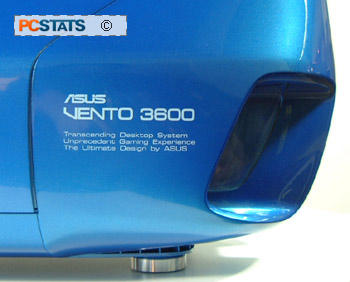The Vento 3600 shipped in a large cardboard box
which was strikingly well decorated for a PC case, complete with full colour
photos of the case on all sides.
The
printed manual included with the Vento 3600 is surprisingly
well written and comprehensive for a case manual, and walks you through
the procedures of installing computer parts into the case with a good amount
of detail and photographs where required. We did notice a fairly
large mistake in the directions though. More on this a little later.
Other
than the manual and the box, the Vento ships with a large bag of screws
(everything you will need plus
extras) and nothing else. Nothing else is required, so this is just fine with
us. Like many designer cases, it's up to you to install your own powersupply.
The first
thing anyone will notice about Asus' Vento 3600 is its strikingly beautiful paint job. The sparkle finish blue-metallic paint
has been applied to the plastic shell of the Vento with
a finish that is more reminiscent of an automotive paint job than anything we've seen recently
on a computer case. We love it, and you will too. Be advised
that it does show smudges and fingerprints very easily, so you might want to
give it a rubdown with a soft cloth once in a while. One
has to wonder how well it would stand up to a car buffer....
 Unfortunately, ASUS has slightly spoiled the effect
of the lovely paint job in our opinion by including small white stencilled
letters on each side of the case near the front. These read:
Unfortunately, ASUS has slightly spoiled the effect
of the lovely paint job in our opinion by including small white stencilled
letters on each side of the case near the front. These read:
ASUS VENTO 3600
Transcending Desktop
System
Unprecedent Gaming Experience
The Ultimate Design by
ASUS
While we
are accustomed to the overblown, poorly written ad copy shipped
with many products from many companies, we don't like to see it plastered on
the side of the product itself where we can't hope to avoid it. This
is a very poor design decision by ASUS in our opinion, as the case
would be much more attractive without the "unprecedent" writing.
Of course, the first thing we did once we had the
Vento 3600 unwrapped was to test the front access panel. Behind the glass
at Computex, it had looked very futuristic and pneumatic, and we couldn't wait to
hear it hiss upwards and lock into place. Boy was it disappointing...
 It turns out that ASUS used a simple spring loaded mechanism
to raise the panel, not the pneumatic system we were hoping for. Pressing the front
panel in releases it from the catch, and this sends it upwards under its own power all right,
but not with the dignified 'sci-fi' cool 'hissss....' that we were hoping for; instead the whole
thing sprang upwards and clattered loudly against the roof of the case with a great big
'thwack!'
It turns out that ASUS used a simple spring loaded mechanism
to raise the panel, not the pneumatic system we were hoping for. Pressing the front
panel in releases it from the catch, and this sends it upwards under its own power all right,
but not with the dignified 'sci-fi' cool 'hissss....' that we were hoping for; instead the whole
thing sprang upwards and clattered loudly against the roof of the case with a great big
'thwack!'
Not only did this slightly ruin the effect of the
case for us, we're also sure that the door will eventually damage the paint on
the top of the case if it is allowed to spring fully up each time its opened, as
it hits with a fair amount of force. Holding your finger on the latch will allow
you to control the speed it opens at, but it's just not the same... like Knight
Rider driving around in a Ford Topaz.
The plastic that ASUS has used
to mold the outer form of the Vento 3600 case is not particularly thick and can
be flexed easily. This makes us think that the case is not going to be too
resistant to dings, dents and scratches, so be careful when moving it
around.
